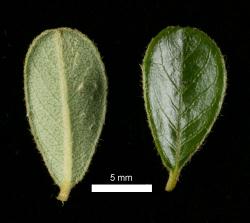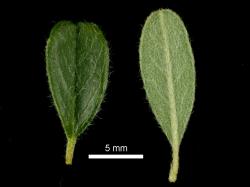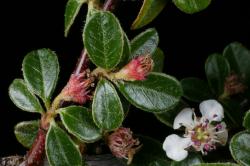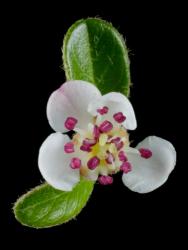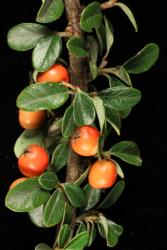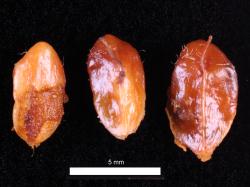Cascading or prostrate shrub, up to 1 m tall, sometimes up to 2 m tall where supported, evergreen or semi-deciduous. Branches distichous, in flattened planes; branchlets red-brown, lenticels present, branchlet hairs sparse to moderately dense, yellow; stipule 2.3–3.3 mm long, green or red with sparse to moderately dense yellow hairs. Leaves crowded on branches, 13–32 mm long, lamina 15–27 mm long, 7.2–16 mm wide, elliptic, slightly V-shaped, 220–350 µm thick, petiole 1.0–6.5 mm long, petiole hairs moderately dense to dense, leaf base cuneate, rarely obtuse, leaf apex obtuse, appearing emarginate, apiculus bent downwards; lateral veins in 4–8 pairs, midvein only or midvein and lateral veins impressed above and projecting below, upper surface smooth to slightly rugose, deep yellowish-green (RHS 141A), moderate olive green to dark green (RHS 136A–137A, moderately glossy, upper surface hairs absent or sparse on the midvein; margins usually recurved, sometimes weakly, marginal hairs sparse to dense on young leaves, absent from old leaves; lower surface glaucous, hairs sparse to moderately dense, straight but fine.
Inflorescence of 1–3 flowers, corymb 15–21 mm long with 2–5 leaves, rachis hairs moderately dense and yellow; pedicel 1.5–10 mm long with hairs moderately dense to dense, yellow. Flowers 9.0–10.5 mm diameter. Hypanthium green, red at the sepal margins, sepals broadly triangular, 1.0–1.3 mm long, 2.0–2.2 mm wide, hairs sparse to moderately dense. Petals pink in bud, white and spreading when open, 2.7–4.3 mm long, 2.5–4.9 mm wide, base clawed, tuft of hairs absent, margins entire, minutely papillose. Stamens 19–24; filaments 2.5–3.5 mm long, white; anthers red–purple, 0.8–1.1 mm long; styles 1–3, 3.0–3.7 mm long. Fruit vivid red (RHS 44A–B), obovoid, 6.7–11.2 mm long, 6.5–10.5 mm diameter, calyx closed or open, glabrous. Pyrenes 2–4(5), 4.4–6.0 mm long, 2.9–4.6 mm wide, hairs sparse at apex, slightly umbonate but style attached at apex.
A prostrate shrub with long cascading branches but older plants form a rather stout trunk that raises the branches to about 0.5–1 m, and is sometimes used as a hedge up to 2 m tall. Leaves of small to medium size are glaucous underneath with sparse strigose hairs. The upper leaf surface is glabrous and semi-glossy. Flowers are mostly solitary; petals are pink in bud, white and spreading once the flower opens. Filaments are white and anthers red-purple. The fruit is vivid red to vivid reddish-orange and obovoid, with 2–4 pyrenes, the style attached at the apex of the pyrene. A description of this hybrid can also be found in Fryer et al. (2014, p. 460).
Most similar to Cotoneaster dammeri, one of its parents, and in New Zealand is more common in cultivation than C. dammeri. Fruit colour is vivid red in both parent and hybrid. The hybrid differs from C. dammeri in having 2–4 styles per flower or pyrenes per fruit rather than (4)5. Typically the number of pyrenes is variable on a plant, while in C. dammeri the pyrenes are usually consistently 5. The leaves are smaller on average than those of C. dammeri but with some overlap (lamina length 15–27 mm vs 23–51 mm). Flower pedicels are short (1.5–10 mm long), whereas they are sometimes very long in C. dammeri (3–23 mm long).
Similar to Cotoneaster integrifolius in the form of the plant, number of flowers, petals pink in bud but white at maturity, petals spreading and entire, filaments c. 20 and white, anthers dark pink, styles usually c. 3. It differs from that species in having larger leaves (24–37 mm long vs 12–19 mm long) that are mid green, not dark green. Branching is less dense than in C. integrifolius and less in one plane, and the branches are weaker so that they cascade or lie flat rather than stiff and are capable of producing a supported shrub up to 3 m tall.
Southern North Island (Foxton, 2010–2016). Common in cultivation in Christchurch and probably elsewhere.
Nominated in this publication.
CHR 609365, C.C. Ogle 5734, 9 Mar. 2010, Foxton, "Wall at base of dune—planted but sprawling and rooting below wall. Covering maybe 5–8 m² of wall and path".
Flowering: late October to February; Fruiting: March, fruit persisting in first half of winter
Diploid (Fryer & Hylmö 2009), confirmed by flow cytometry using CHR 635037 and CHR 637362. However, CHR 638103 was mixaploid (diploid and tetraploid) in both fruit and leaves.



